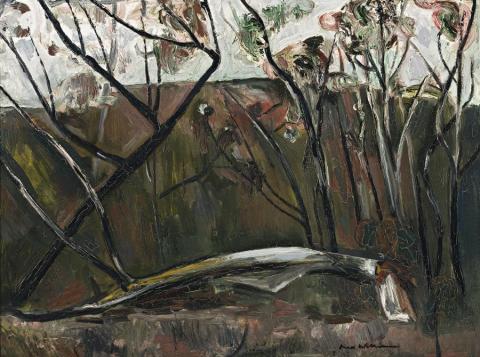TREES, c.1958-59
Fred Williams
oil on board
45.0 x 60.5 cm
signed lower right: Fred Williams
Rudy Komon Gallery, Sydney
Private collection, Sydney
When Fred Williams returned to Australia in late 1956, his friend John Brack asked him what he was going to do. 'Williams: I am going to paint the gum tree. Brack: You can't do that. Everybody's done that. Williams: Well it's just what I'm going to do.'1 After many years working as a figurative painter in England, he was seeing the Australian landscape through fresh eyes. From the outset his landscapes were distinguished by that unique individuality found throughout his oeuvre. More traditionally pictorial than his minimalist paintings of the 1960s, their appeal lies as much in their imagery and colour as in the very handling of the paint itself. Trees, c.1958-59, like its contemporaries, is so evocative that we tend, as with his later paintings, to see the landscape very much through Williams' eyes. Attuning his style to the new scene, Williams initially retained the sky and horizon line, as in Landscape with Steep Road, 1958, in the collection of the National Gallery of Australia, Canberra, with an emphasis on the flatness of the pictorial surface. The road, as it were, climbs up the picture rather than creating an illusion of depth. This same flatness is a characteristic of Nattai River, 1957-58, in the National Gallery of Victoria, the first work by Williams to be acquired by a public gallery. As in Trees, c.1958-59, Williams worked within a shallow pictorial space, the motifs of gums almost pressed up against the painting's surface giving an intimate view of the trees and dense scrub. Always a classicist, verticals and horizontals are kept in balance, the horizontal curve of the fallen gum acting as a counter weight to the screen of upright trunks. The prominence given to the horizontal foreground motif is a characteristic of his paintings at this time, as seen in the line of the creek in the splendid Black Creek, 1958, and the two versions of Landscape with Rocks of the late 1950s. As often in his art, Williams returned to the motif of the fallen gum before a screen of trees in Scrub at Lilydale, 1958-59. In our painting the focus of attention on the fallen trunk is heightened by its pleasing curve, echoed in the other trees. Soon dispensed with for more rigid, denser imagery, Williams' stylistic development also parted with the skyline, as in Sherbrooke Forrest, 1959, in the collection of University College, Melbourne. Trees, c.1958-59, is an important work in the appreciation of this development. Moreover, in addition to showing Williams' early response to the Australian landscape, it has considerable aesthetic appeal in its pleasing articulation of forms and tactile painterliness.
1. Fred Williams and John Brack, Melbourne January 1957, recalled by Hal Hattam in a 1987 interview with James Mollison, quoted in Mollison, J., A Singular Vision: The Art of Fred Williams, Australian National Gallery, Canberra, 1989, p. 35
DAVID THOMAS
